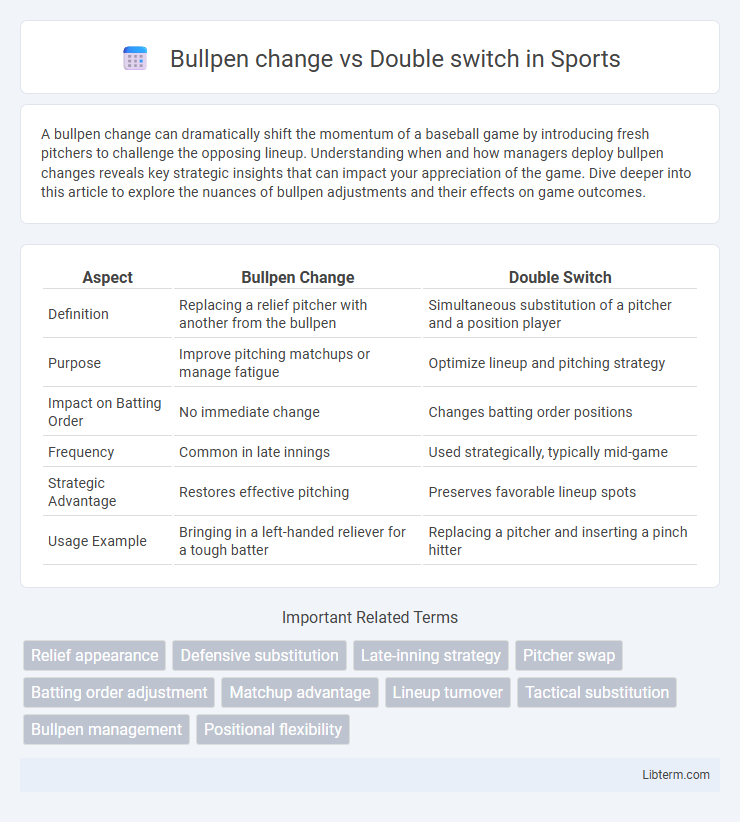A bullpen change can dramatically shift the momentum of a baseball game by introducing fresh pitchers to challenge the opposing lineup. Understanding when and how managers deploy bullpen changes reveals key strategic insights that can impact your appreciation of the game. Dive deeper into this article to explore the nuances of bullpen adjustments and their effects on game outcomes.
Table of Comparison
| Aspect | Bullpen Change | Double Switch |
|---|---|---|
| Definition | Replacing a relief pitcher with another from the bullpen | Simultaneous substitution of a pitcher and a position player |
| Purpose | Improve pitching matchups or manage fatigue | Optimize lineup and pitching strategy |
| Impact on Batting Order | No immediate change | Changes batting order positions |
| Frequency | Common in late innings | Used strategically, typically mid-game |
| Strategic Advantage | Restores effective pitching | Preserves favorable lineup spots |
| Usage Example | Bringing in a left-handed reliever for a tough batter | Replacing a pitcher and inserting a pinch hitter |
Understanding the Bullpen Change
A bullpen change in baseball involves substituting a relief pitcher during an inning without altering the batting order, allowing the new pitcher to face specific matchups or situations. This strategy helps managers optimize pitching matchups while maintaining the current lineup sequence. Understanding the bullpen change is crucial for analyzing in-game tactical decisions and pitcher performance metrics.
What is a Double Switch?
A double switch in baseball is a strategic substitution involving two players, typically a pitcher and a position player, made simultaneously to optimize the batting order and defensive alignment. This maneuver allows managers to replace the pitcher while also adjusting the lineup to avoid an upcoming weak hitter, effectively improving both pitching and offensive potential. Unlike a bullpen change, which only focuses on bringing in a new pitcher, the double switch influences both pitching strategy and lineup configuration.
Key Differences: Bullpen Change vs Double Switch
A bullpen change involves replacing the current pitcher with a reliever without altering any position players, allowing the manager to optimize pitching matchups. A double switch simultaneously substitutes a pitcher and a position player, rearranging the batting order to delay the pitcher's turn at bat, often used in National League strategies. The key difference lies in the double switch's strategic impact on both defensive alignment and lineup, whereas a bullpen change focuses solely on pitching.
Strategic Impact on Game Management
Bullpen changes allow managers to optimize pitching matchups by replacing one pitcher without altering the entire defensive lineup, preserving defensive stability and focusing on situational advantage. A double switch strategically replaces both a pitcher and a position player, altering the batting order to delay the new pitcher's turn at bat, maximizing offensive potential while managing pitching fatigue. Effective use of bullpen changes and double switches enhances game management by balancing pitcher effectiveness, lineup flexibility, and timing, directly influencing late-inning performance and run prevention.
Situational Usage in Modern Baseball
Bullpen changes are primarily used to strategically manage pitcher matchups and maintain optimal arm freshness during late innings, especially in high-leverage situations or when facing specialized hitters. Double switches are more common in National League play, allowing managers to optimize both pitching and batting order simultaneously by replacing a pitcher and a position player, thereby improving defensive alignment and batting efficiency without costly pinch-hitting decisions. Modern baseball increasingly leverages bullpen changes due to expanded bullpen usage and analytics-driven specialization, while double switches remain situationally valuable for roster flexibility and maintaining lineup balance in leagues without a designated hitter.
Advantages of the Bullpen Change
Bullpen changes allow managers to quickly deploy specialized pitchers, enhancing matchup advantages against specific batters without altering the batting order. This strategy preserves offensive continuity by avoiding the need to substitute position players, unlike the double switch, which requires replacing a fielder and changing the lineup. By minimizing disruptions to both pitching roles and offensive tactics, bullpen changes provide greater strategic flexibility in late-game situations.
Benefits of Employing the Double Switch
The double switch allows managers to simultaneously replace a pitcher and a position player, optimizing both the batting order and defensive alignment without sacrificing offensive potential. This strategic move preserves bench flexibility by minimizing the number of substitutions, which is crucial late in the game. Employing the double switch enhances pitcher endurance management and maintains lineup strength, offering a tactical edge in close contests.
Challenges and Risks of Each Strategy
Bullpen changes can disrupt pitcher warm-ups and increase game pace, risking diminished pitcher effectiveness and potential for injuries due to sudden workload. Double switches require precise timing and coordination, posing challenges in maintaining optimal lineup balance and potentially reducing offensive opportunities. Both strategies demand acute managerial decision-making under pressure, with missteps leading to compromised bullpen depth or weakened defensive alignment.
Notable Examples in MLB History
Bullpen changes and double switches are strategic moves that have shaped many memorable MLB moments. Notable bullpen changes include the 2014 World Series Game 7, when the Kansas City Royals made pivotal pitching substitutions that secured their victory. In contrast, the double switch is famously associated with Tony La Russa, who used it deftly to optimize both pitcher's spot and defensive alignment, such as in the 1985 World Series with the Chicago White Sox.
Future Trends in In-Game Substitutions
Bullpen changes and double switches are evolving with the integration of advanced analytics and real-time data to optimize player matchups and game outcomes. Future trends indicate a growing reliance on AI-driven decision tools to determine the most effective pitcher changes and positional adjustments, enhancing strategic depth in baseball. Teams are expected to adopt more dynamic in-game substitutions, leveraging predictive modeling to anticipate opponent strategies and maximize roster efficiency.
Bullpen change Infographic

 libterm.com
libterm.com